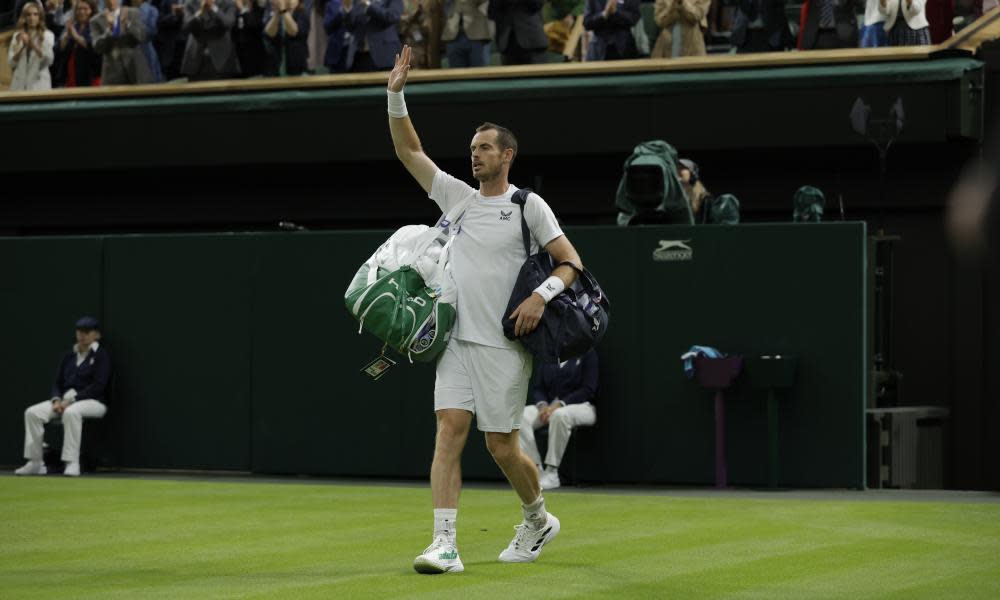John Isner’s heavy metal game drums Andy Murray out of Wimbledon

Amid fevered scenes akin to a revivalist meeting, Andy Murray tried his damnedest to conjure up one last famous late night Centre Court miracle. But father time – and the crunching heavy metal tennis of John Isner – offered a crushing riposte.
Afterwards Murray pledged to be back at Wimbledon if his creaking 35-year-old body holds up, but he conceded that was not a given. It only made this 6-4, 7-6 (4), 6-7 (3), 6-4 defeat, his earliest ever in 14 appearances here, sting even harder.
Related: Wimbledon day three: Murray and Raducanu knocked out, Djokovic wins – live!
Some of it, though, was out of his control. Over three hours his opponent was a gunslinger who refused to miss, crashing down an extraordinary 36 aces and 80 winners to secure a deserved win. “It’s no secret that I am not a better tennis player than Andy, but I may have been a little bit better today,” he magnanimously conceded. “This was one of the biggest wins of my career.”
As Isner later acknowledged, there is nothing particularly sophisticated about his game. Yet why reinvent the wheel when you possess a howitzer of a serve, and a forehand that tears seven strips of nylon off the ball? The American might be the tennis equivalent of a garage band who has mastered three cords. But he still confounded Murray with his Blitzkrieg Bop.
“I’ve played many times against those players and found ways to make enough returns to turn the matches, whether that’s been against Karlovic, Isner, Raonic, those sorts of guys,” said a downbeat Murray afterwards. “But tonight he was very close to the lines in important moments.”
But, as much it will pain the Wimbledon crowd who have cheered him royally down the years, this was Murray offering a portrait of the artist as an older man. Still supremely talented, sure. But a little slower in the eyes, and between the lines. In a game of millimetres and microseconds, it made all the difference.
“I think most of the players on the tour would tell you that a match like that is won or lost based on a few points here and there,” Murray said. “I didn’t play well enough on those points.”
Beforehand, the bookies had made Murray, who had won all eight of his previous contests against Isner, a strong favourite. But he also knew those victories were all years ago, before his body broke down and his hip was resurfaced.
Given the supreme difficulty of breaking Isner’s serve it was vital Murray made a fast start. Instead he was broken in the third game. The Scot immediately had two chances to return the favour, only for Isner to save them – first with a deft volley and then a 128mph first serve. Incredibly, Murray did not get another opportunity to break in the contest.

After the losing the first set 6-4, Murray stabilised and had half a chance of a break when 30-15 up on Isner’s serve at 5-4 in the second. But then the American hit two exquisite drop volleys, showing that he had a surprisingly good touch for a big man, to hold serve before racing away with the tie-break.
Murray was now in desperate straits. To add to his woes, Isner was getting 79% of first serves in – a staggering percentage given many were flying past the speed gun at 130mph-plus – and winning 88% of his first-serve points.
Related: Cameron Norrie survives five-set struggle to reach third round
Murray’s best hope now was that his fellow veteran, at 37 and having played a five-setter on Monday, might start feeling some lead in his legs. “Come on Andy, he’s older than you!” cried one wag, but Isner’s serve held firm as we headed into another tie-break.
This time it was Murray who made a fast start, rushing to a 3-0 lead. And with the crowd urging him on, he was able to capitalise. By now the fans were on their feet and punching the air. Murray couldn’t do it, could he?
But Isner was not in any mode to oblige. A break at 2-2 in the fourth set put the match on his racket and he was able to hold his nerve even after a delay to close the stadium roof.
Murray, meanwhile, was left to hope that this will not be his final day on this most famous of courts. “If physically I’m in a good place, I will continue to play,” he said. “But it’s extremely difficult with the problems I’ve had with my body in the last few years to make long-term predictions.”
His words felt bruised, and a little dazed. That, though, was only to be expected given the battering he had just experienced.

 Yahoo Movies
Yahoo Movies 
